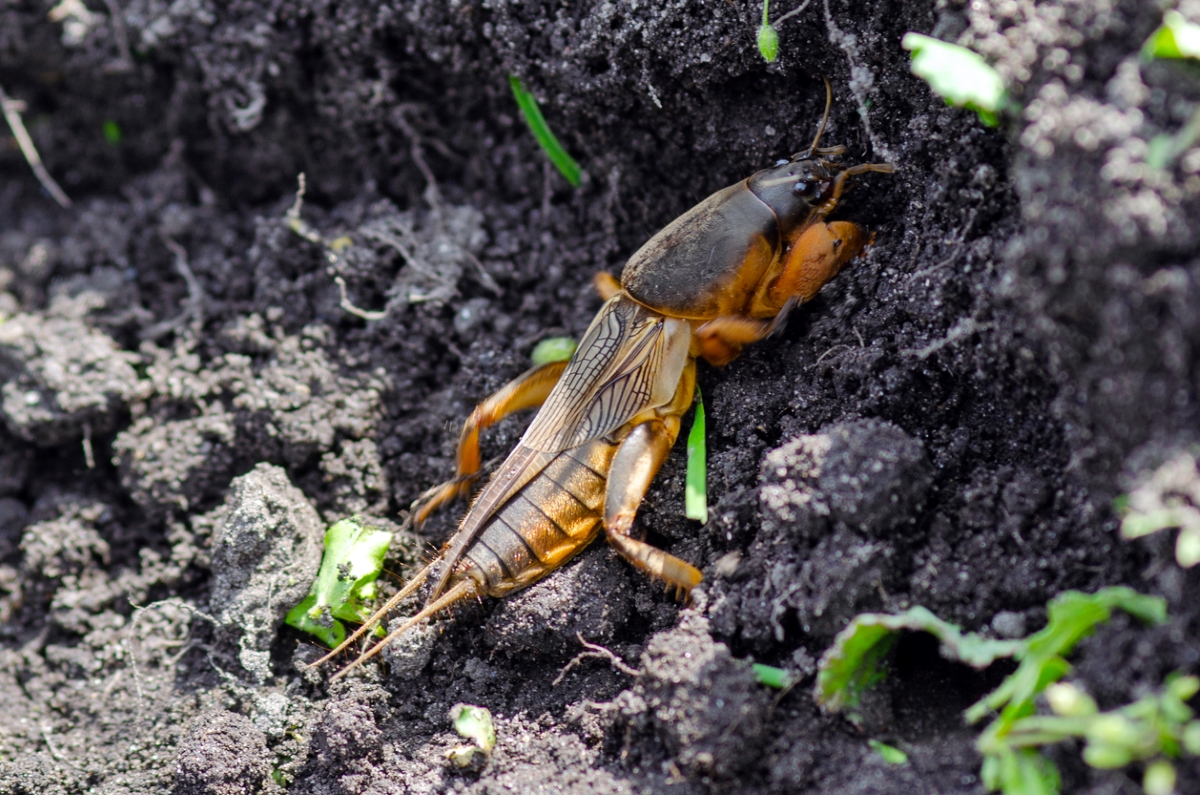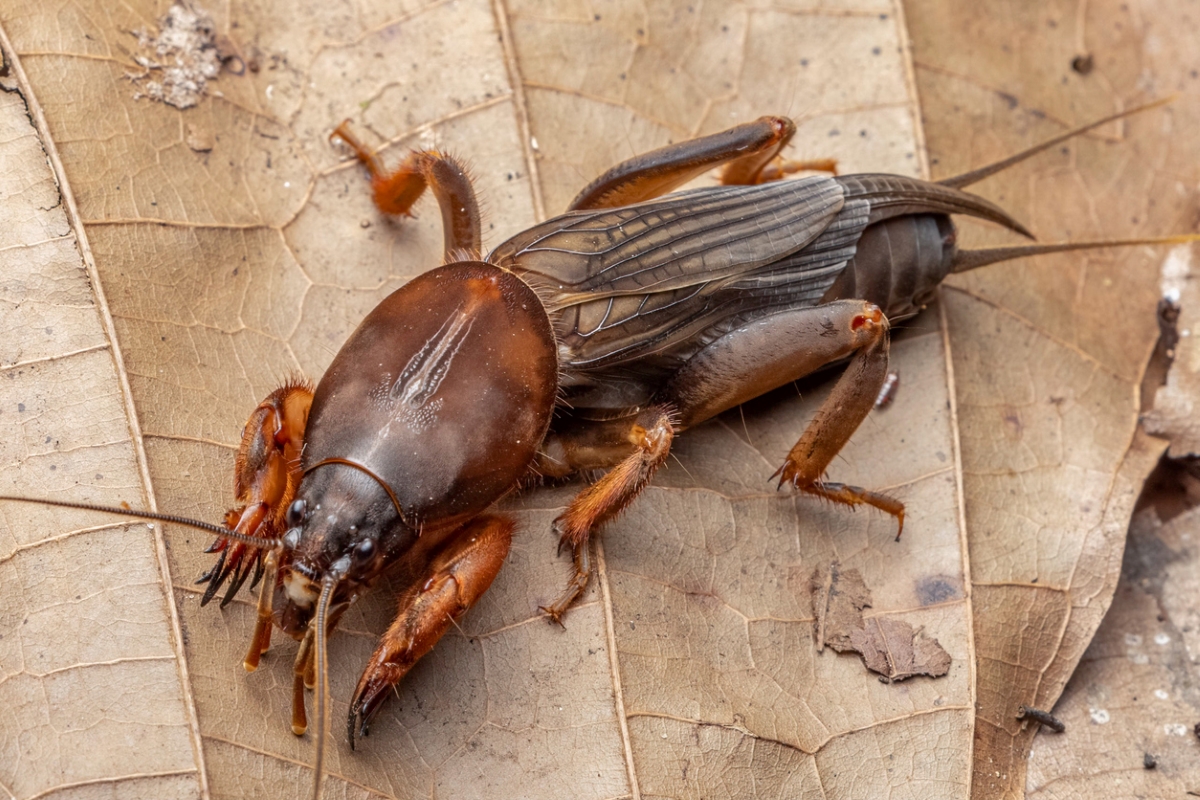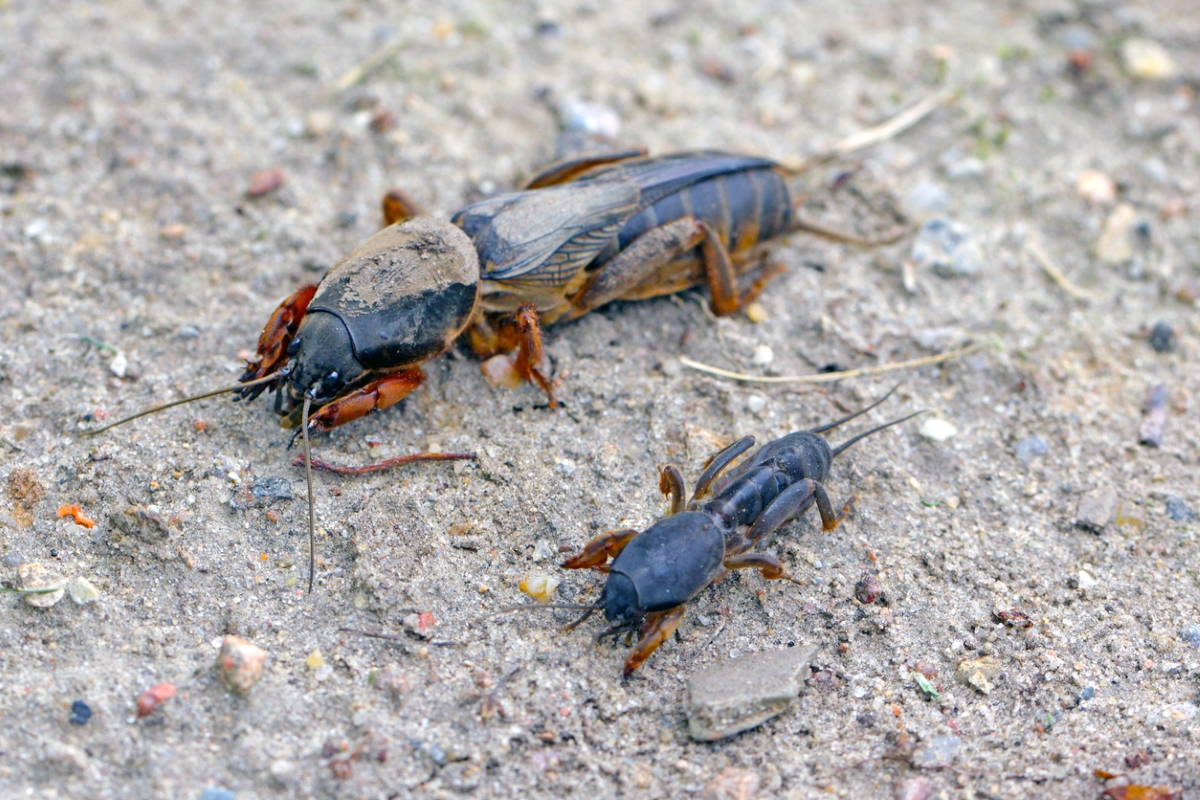

We may earn revenue from the products available on this page and participate in affiliate programs. Learn More ›
If you live in the Southeastern United States, you might be dealing with a mole cricket problem. These pests (which are sometimes confused with cockroaches) may eat grass or its roots, uproot grass by making tunnels, disturb the soil, and cause a lot of lawn damage. They prefer Bermuda grass, bahia grass, and other warm-season turfs.
If these bugs are threatening your lawn, you’re likely eager to learn how to get rid of mole crickets. Below, we’ll discuss how to identify mole crickets, the damage they can cause, and the best way to get them to leave your lawn alone.
Identifying Mole Crickets

Mole crickets belong to the Gryllotalpidae insect family. This is under the order Orthoptera, making mole crickets relatives of locusts, crickets, and grasshoppers.
Adult mole crickets are typically between 1 and 2 inches long with three body segments, six legs, and two antennae. While this sounds like a typical insect, mole crickets look rather odd—almost as if a mole’s or lobster’s head and paws/claws were placed on a cricket’s body. Like a mole’s paws, their front legs have claws that help them dig in the ground.
Common Types of Mole Crickets
Three mole cricket species are responsible for damage caused in the Southeastern U.S. Two additional species, European mole crickets and northern mole crickets, also live in the United States, but they’re far less destructive and are not classified as pests.
- Tawny mole cricket: Tawny mole crickets have tan bodies and grow to be larger than other mole cricket species, reaching a length of about 2 inches when fully grown. They are found in Florida and between North Carolina and Louisiana.
- Southern mole cricket: An adult Southern mole cricket grows up to around 1½ inches long. These dark-brown crickets can be found between North Carolina and Florida and as far west as Arizona.
- Short-winged mole cricket: Short-winged mole crickets are reddish-brown and smaller than tawny and Southern mole crickets, typically only growing about 1 inch long. They can be found in southern Georgia and South Florida.
Mole Cricket Life Cycle

A mole cricket’s life cycle consists of three main stages: egg, nymph, and adult.
- Egg: Adult mole crickets lay between 25 and 60 eggs in spring and summer. They deposit these eggs in pre-dug channels within soil, where they’ll remain until hatching within 40 days of being laid. The eggs are very small (only about 3 millimeters long) and either brown or gray in color.
- Nymph: From these eggs emerge mole cricket nymphs. Nymphs are white at first, but their color changes to a darker brown within 24 hours. Aside from underdeveloped wings, nymphs otherwise look similar to adult mole crickets. During the nymph stage, which lasts from July to October, mole crickets typically grow across eight shedding periods.
- Adult: After the final shedding, nymphs become adult mole crickets. Adults have fully developed legs and use their claw-like front legs to dig in the soil. Male mole crickets seek to attract females through mating songs. Most mole crickets live for a year or less.
Signs of Mole Cricket Damage
There are several signs of a mole cricket infestation. One indicator of mole cricket damage are tunnels along the lawn. While these tunnels within the soil may not be visible, you can often spot their presence due to lines of pushed-up grass or soil along the lawn. According to the University of Georgia Extension, most mole cricket damage is caused by tunneling. Larger nymphs and adult mole crickets make the largest and most damaging tunnels.
Mole cricket holes can also indicate a problem. Mole crickets dig these holes—which look like piles of dirt with an opening on top—during the spring for egg-laying. Dead or dying grass can also alert you to a mole cricket problem. In addition to the damage their tunneling can cause to grass, mole crickets may also eat grass and its roots.
RELATED: The Bug Behind Your Patchy, Brown Grass
How to Get Rid of Mole Crickets
Getting rid of crickets, including mole crickets, can take some time and effort. Before resorting to using chemical insecticides, try more natural and environmentally friendly methods to clear up a mole cricket infestation. It also helps to ensure a turf problem is being caused by mole crickets and where the insects might be concentrated. Clemson Cooperative Extension recommends a soapy water drench in spots where mole crickets are suspected.
Tools & Materials
Bobvila.com may earn a commission from purchases made through these links.
BEFORE YOU BEGIN
There are a few different approaches when it comes to how to kill mole crickets. If, after trying natural methods, you choose to use a chemical insecticide, remember to carefully read and follow the manufacturer’s directions to minimize any health and safety concerns.
STEP 1: Introduce nematodes into the soil to kill mole crickets.

Nematodes can be used as a natural mole cricket treatment option. Nematodes are a beneficial parasite that will infect and kill mole crickets with bacteria. Additionally, nematodes can deliver additional benefits to your yard by improving the soil’s overall quality and acting as a source of food for other beneficial organisms in the soil.
Nematodes are more likely to kill adult mole crickets than nymphs, so it’s typically recommended to apply them to the soil in late summer or early fall. Though nematodes can be quite effective at killing adult mole crickets, don’t expect immediate results. It may take some time for them to clear up a mole cricket infestation on their own.
STEP 2: Apply chemical insecticide to moist soil.
If nematodes don’t get rid of your mole cricket problem, you may need to consider a chemical insecticide. Both liquid and granular varieties can be used, but first confirm that your chosen product’s active ingredients are effective against mole crickets. Some ingredients to look for include carbaryl, gamma-cyhalothrin, bifenthrin, and imidacloprid.
An insecticide will be most effective when applied to moist soil, so plan on giving your lawn a deep watering for a few days before using the chemicals. Follow the manufacturer’s directions for application, or consider hiring a professional to ensure the chemicals are applied properly.
The best time to apply mole cricket insecticide can vary based on the product you choose, but many are most effective when used on smaller nymph mole crickets, who dwell closer to the surface. Mole crickets are typically in the nymph stage between July and August, so plan on applying the insecticide then. Applying insecticide during the fall can also be effective to kill off more mole crickets before they begin overwintering well beneath the soil surface.
STEP 3: Prevent mole crickets from returning to your yard.

After clearing up a mole cricket infestation, there are a few measures you can take to help prevent them from returning to your yard. Most importantly, continue to monitor your lawn for signs of mold crickets, as ridding the turf of them takes time.
Bright lights can attract mole crickets, so switching out bright light bulbs with yellow bug lights—or working to limit the use of exterior lights outside your house—can help keep the bugs from coming back. Chrysanthemums and marigolds are believed to be natural mole cricket deterrents, so planting them around your property may also discourage their return while adding nice annual color to the landscape.
Keeping a lawn healthy with proper soil nutrients, organic fertilizing, and aeration can help keep grass healthy and less prone to insect damage. Preventing thatch from building up with regular raking or dethatching can help aerate the lawn and minimize risk of mole cricket infestation.
If these natural methods fail, you may want to consider using preventive chemical treatments with systemic bifenthrin or imidacloprid.
RELATED: How to Get Rid of Armyworms
Final Thoughts
Mole crickets can cause serious damage to turf grass. In addition to feeding on the grass and its roots, they dig tunnels through soil, uprooting grass and seedlings in the process. Fortunately, there are measures you can take to get rid of mole crickets and keep them from coming back to your property. To protect natural resources and minimize your impact, remember to try natural elimination methods—such as introducing nematodes—before resorting to chemical insecticides.
FAQ About Mole Crickets
Read through the frequently asked questions below to learn more about mole crickets, signs of a mole cricket infestation, and how to get rid of mole crickets in your yard.
Q. Are mole crickets harmful?
While mole crickets can cause a lot of damage to a lawn, they are not harmful to people. They are unlikely to bite unless handled or provoked. However, should a mole cricket bite you, it is unlikely to be very painful and isn’t anything to be seriously worried about.
Q. How long do mole crickets live?
Mole crickets typically only live for a year or less. The males die shortly after mating with a female, and the females tend to die shortly after laying their eggs.
Q. What attracts mole crickets?
Mole crickets prefer lawns with a thicker layer of thatch (decomposed leaves and grass clippings along the top of the soil). They are also attracted to lights.
Q. What are the signs of mole crickets?
Dead or dying grass, tunnels just below the surface of the soil, and small piles of dirt with holes in the center are all possible signs of mole crickets.
Q. Does soapy water kill mole crickets?
No, soapy water doesn’t kill mole crickets. However, you can use a mixture of dish soap and water to flush out mole crickets and determine whether you have an infestation. Pouring 2 gallons of water mixed with 1 to 2 ounces of dish soap can bring mole crickets to the surface of the soil.
After you pour the mixture on a small section of your lawn, stand and observe for a few minutes. If you see more than two mole crickets come up, then you should start taking measures to clear up an infestation.
Q. Are mole crickets hard to kill?
Because mole crickets can burrow deep beneath the soil’s surface, killing them can be challenging and will take patience.
